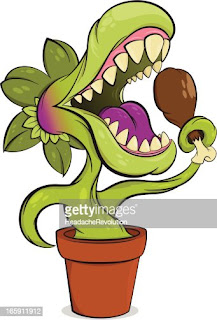Venus Fly Trap -The Carnivorous Plant that fights back
Venus Fly Trap
The Carnivorous Plant that fights back
When you think of carnivorous plants, what comes to mind? Maybe a large, dangerous-looking plant in a horror movie, or a bizarre creature from an alien planet. But did you know that there's a carnivorous plant that's small enough to fit in the palm of your hand, and it's found right here on Earth? Meet the Venus flytrap, a fascinating and unique plant that is as captivating as it is mysterious.
.png) |
| image credit: pexels |
Origin & Naming
The Venus flytrap (Dionaea muscipula) is one of the ancient plants that exist for about 150 million years and evolved into today’s flytrap. It is originally found in the USA. Their existence is now vulnerable. As they appeared to flourish in locations where meteorites were discovered, Venus flytraps were initially thought to be an alien species. They were believed to have come to Earth by meteors. It has beautiful white flowers and thus it has been named after the Greek goddess Venus.
| image credit: DALL.E 2 |
Diet
Now, are you wondering what this carnivorous plant eats? Due to their diminutive size, these plants mostly eat tiny insects that resemble critters. Also, despite their name, flytraps rarely prey on flies.
1) Venus flytraps have a carnivorous diet that consists mainly of small insects and arachnids such as spiders, ants, flies, and beetles.
2)The Venus flytrap's diet is important for its survival, as it provides the plant with essential nutrients such as nitrogen, phosphorus, and potassium that are often lacking in the soil of its wetland habitat.
3)Venus flytraps are not able to consume large prey and will only capture insects that are small enough to fit inside their traps.
4)The Venus flytrap's digestive process begins as soon as the trap closes around its prey, with enzymes breaking down the insect's exoskeleton and soft tissues.
5)While Venus flytraps are capable of capturing and digesting small animals, they still require photosynthesis in order to produce energy and survive and will continue to use their leaves to capture sunlight and produce food.
Mechanism & Intelligence
From Science to Screen
In addition to its scientific significance, the Venus Flytrap has also captured the imagination of artists, writers, and filmmakers throughout history. It has been featured in countless works of literature, from Charles Darwin's "Insectivorous Plants" to Edgar Allan Poe's "The Murders in the Rue Morgue." It has also appeared in numerous movies and TV shows, from "The Journey to the Center of the Earth" (2008) to "Wednesday" (2022)
FAQs
1) How to collect them?
Ans. Venus flytraps are a protected species in the wild and it is illegal to collect them without a permit. As it is forbidden to collect when seen, it can be collected from imported nurseries that keep exotic plants collection.
2) Do they catch prey once in a lifetime?
Ans. The answer is no. The digestive process of the Venus flytrap can take up to a week, and once the prey is completely digested, the trap will reopen.
3) Where is it mostly used?
Ans. Venus flytraps have been used in scientific research to study plant biology, genetic engineering, and even to develop new medical treatments.
4)Do they have ecological importance?
Ans. Yes, they have. It helps to reduce the number of pest species that could otherwise cause damage to plants or other animals in the area.
In conclusion, the Venus flytrap is a fascinating and unique plant that has captured the attention of people around the world. From its carnivorous diet to its important role in local ecosystems, there's no denying that this plant is truly remarkable. Whether you're an avid gardener or just someone who appreciates the wonders of nature, the Venus flytrap is a great reminder of the incredible diversity of life on our planet. So next time you come across a Venus flytrap, take a moment to appreciate the incredible complexity and beauty of this amazing plant.
this blog is written by-
Sumaiya Islam Amy
&
Jigme Loday Jamtsho




.jpg)
Comments
Post a Comment